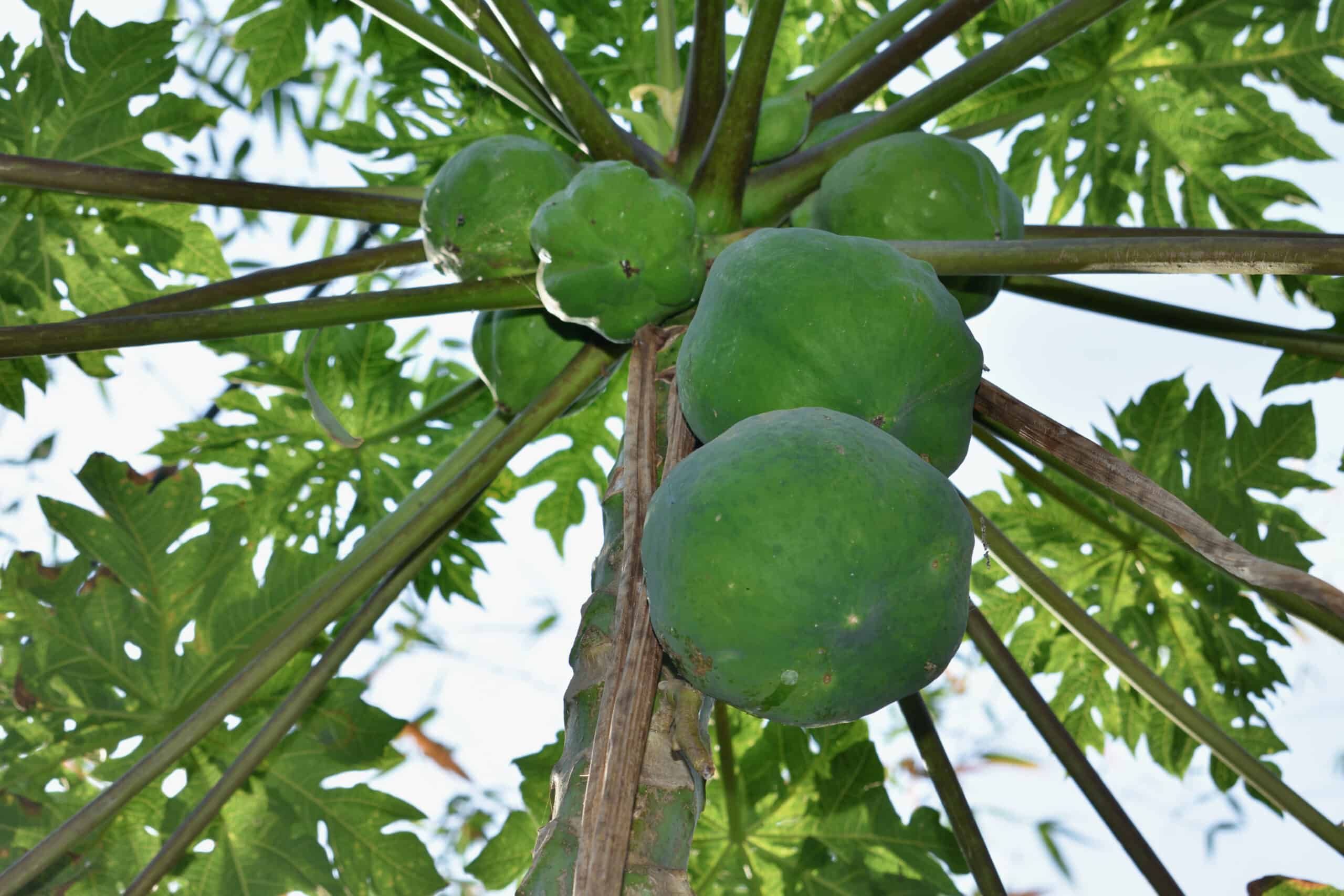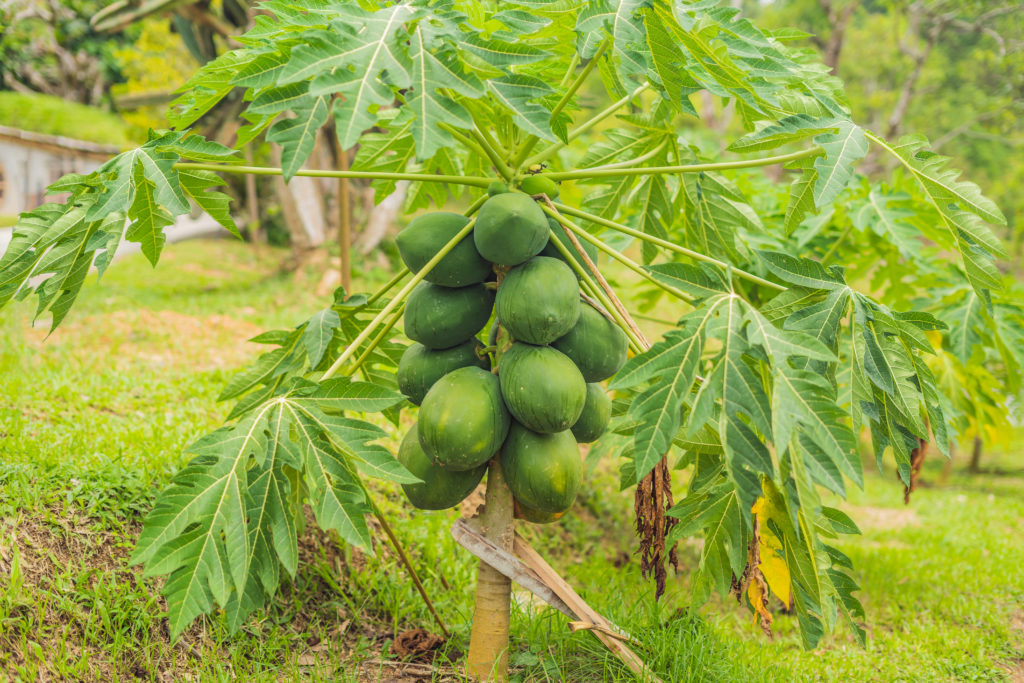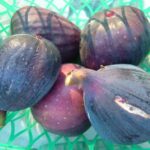Papaya is a fruit that is often enjoyed by people all over the world. It is known for its sweet and juicy taste, and it can be eaten as is or used in various recipes. One of the great things about papaya is that it is a fairly easy fruit to grow, and it can be grown both indoors and outdoors.
If you are interested in growing your own papaya, you will first need to find a papaya seed. You can either purchase a seed online or from a local store. Once you have a seed, you will need to plant it in a pot or in the ground, and then you will need to water and fertilize it regularly. In a few months, you will start to see the fruit begin to grow.

When growing papaya, it is important to make sure that the fruit is exposed to plenty of sunlight. In addition, you will need to make sure that the soil is moist at all times. Papaya trees can grow up to 15 feet tall, so make sure you have enough space for it to grow.
If you are looking for a delicious and nutritious fruit to add to your garden, then consider growing papaya. It is a fruit that is enjoyed by people all over the world, and it is a fruit that is easy to grow.
Grow papaya in tropical and subtropical regions. Papaya is an evergreen tree that grows 8 to 30 feet tall depending on the variety.
Papayas are native to Mexico and northern South America. In the United States, they are grown in Florida, Texas, Southern California, and Hawaii.
Here is your complete guide to growing papaya.
Two types of papaya
There are two types of papaya: Hawaiian or “yellow papaya” and Mexican or “red papaya”.
Yellow or Hawaiian papaya has yellow skin when ripe. Hawaiian papayas are pear-shaped and commonly weigh about one pound. The flesh is bright orange or pinkish depending on the variety. Yellow papaya has a sweet, tropical-flavored when ripe. Yellow papaya trees seldom grow taller than 8 feet.
Red or Mexican papaya has red skin when ripe. Mexican papayas are pear to oval-shaped; they are much larger than Hawaiian papayas, up to 15 inches long, and they weigh as much as 10 pounds or more. The flesh of the Mexican papaya can be yellow, orange, or pink. The red papaya is less sweet than the Hawaiian papaya. Mexican papayas commonly grow 10 to 12 feet tall; in tropical regions, they can grow to 30 feet tall.
The best climate for growing papaya
- Papayas grow best where the year-round temperature averages between 70°and 90°F; grow papaya in USDA growing zones 9 to 12. Papaya is very frost sensitive; temperatures below 29°F will damage and may kill the tree. Root growth will be slowed by temperatures below 60°F. Flowers can drop when temperatures exceed 90°F (32°C) or drop below 59°F (15°C).
Where to plant papaya
- Plant papaya in full sun; in partial shade the fruit is not likely to sweeten.
- Plant papaya in a warm spot where there is plenty of sun and heat. Choose a south-facing spot against a wall that reflects heat when possible.
- Avoid planting papaya where there is a constant breeze and avoid planting in low spots that collect cold air. Wind can damage the fruit or topple the tree.
- Papaya grows best in sandy, well-drained soil. Papaya trees will not survive water-logged soil for more than a day. Where the soil can be damp, plant papaya on a mound to ensure good drainage.
- Papayas prefer a soil pH of 5.5 to 6.5.
Choosing the right papaya plant
- Yellow-skinned Hawaiian papaya has a richly sweet, tropical flavor; the fruit will weigh about one pound. The tree grows to about 8 feet tall.
- Red-skinned Mexican papaya has a mellow sweet flavor, less intense than Hawaiian papaya; the fruit will weigh about 10 pounds. The tree grows 10 to 12 feet tall.
- When selecting papaya at a nursery, choose a plant that stands 6 inches to 2 feet tall and grows in a 1- to 3-gallon container. Avoid tall plants in small pots; they can be root bound.

Planting papaya
- Prepare a planting site in full sun that is sheltered from a prevailing breeze or wind.
- Space papaya plants 7 to 10 feet (2.1-3.1m) apart. Spacing male and female plants 7 to 12 feet apart will increase the probability of wind pollination.
- Dig a hole half again as deep and twice as wide as the tree’s roots. Add a cupful of all-purpose fertilizer to the bottom of the hole.
- Work well-rotted compost or manure into the soil.
- The top of the tree’s rootball should be level or slightly above the surrounding soil level.
- Put a tree stake in place before planting. Drive the stake into the ground to the side of the hole to at least 2 feet deep. Papayas are shallow-rooted; they should be staked at planting time.
- Set the plant in the hole so that the soil mark from the nursery pot on the stem is at the surface level of the surrounding soil. Spread the roots out in all directions.
- Re-fill the hole with half native soil and half aged compost or commercial organic planting mix; firm in the soil so that there are no air pockets among the roots. Water in the soil and create a modest soil basin around the trunk to hold water at watering time.
- Secure the tree to the stake with tree ties or elastic horticultural tape.
- After planting, water the tree thoroughly and fertilize with a high-phosphorus liquid starter fertilizer.
- In areas where the water table is high, plant papaya on a mound of native soil 2 to 3 feet high and 4 to 8 feet in diameter.
Container growing papaya
- Papaya can be grown in a container. Choose a container 24 inches wide and deep. Use a citrus or palm potting mix that is well-drained. Choose a dwarf variety to grow.
How to water papaya
- Papayas need regular water during the growing season, but their roots can not sit in water. Be sure the soil is well-drained. Papayas are susceptible to root rot.
- Evenly moist soil is essential for best papaya fruit production; if the soil goes dry leaves, flowers, and fruit may drop.
- Keep the soil on the dry side in winter.
How to fertilize papaya
- Fertilize papayas with an organic fertilizer slightly higher in phosphorus than nitrogen and potassium–such as 5-10-5.
- Feed papayas monthly during the growing season.
Papaya care
- Mulch around papaya trees to retain soil moisture and reduce weeds. Keep mulch 6 to 12 inches back from the trunk.
- Protect papaya from frost. Cover the plant with a frost blanket or erect a frame around the plant and drape clear plastic over the frame to form a mini-greenhouse. Place electric lights inside the frame to provide additional warmth. Mexican papayas are hardier than Hawaiian varieties.
Pruning papaya
- Papayas do not require pruning. The main growing point is terminal and should not be pruned away.
- Plants yield best on a single trunk; clip away sprouts to ensure a single trunk.
- As papaya plants mature allow 1 or 2 vigorous shoots to grow; they will produce fruit. Remove less vigorous shoots.
- Staking a main stem or shoots will reduce the possibility of wind damage or breaking.
Papaya pollination
- Papaya plants grow in three sexes: male, female, and hermaphrodite. Some trees produce only male flowers and so can never bear fruit; some produce only female flowers and require pollination to bear edible fruit; some have both male and female flowers and can self-pollinate.
- The sex of papaya can change during its life; this seems to be triggered by drought and variables in temperature. The tendency to produce male flowers seems to increase at high temperatures.
- Papaya plants can be self-pollinating (bisexual plants) or cross-pollinated. Female flowers are pollinated by insects or pollen carried by the wind. Pollinators include honey bees, wasps, midges, thrips, surphid flies, and butterflies.
- Hand pollination is one way to ensure pollination and fruit set.
- Fruits from female trees are larger, rounder, and thinner-walled than fruits from hermaphroditic trees. Fruits from bisexual plants have smaller seed cavities. Male plants with bisexual flowers may produce a few pear-shaped, poor-quality fruits.
Papaya yield
- A papaya tree can produce as many as 100 fruits in a growing season. A tree can yield 60 to 80 pounds of fruit in a 12-mont period.
- Cool or cold temperatures, lack of water, constant wind, or shade will reduce papaya growth and production.
- Best papaya fruit production occurs where temperatures are warm year-round, 70-90°F (21-32°C).

When to pick papaya
A ripe papaya will be aromatic and give slightly to gentle pressure. The flesh of ripe papayas is juicy with a buttery consistency. Small black seeds about the size of caviar are clustered at the center of the flesh; the seeds are edible and have a peppery taste.
Papaya picked unripe and green is called “green papaya”. Green papayas have a sour taste.
How to harvest and store papaya
- Papayas bear fruit within a year of germination. Papaya plants produce flowers about 4 months after planting and fruit 7 to 11 months after planting.
- Ripe papaya turns either yellow or an amber to orange hue depending on the type. A ripe papaya will be aromatic and give slightly to gentle pressure.
- Papaya can be picked green and will ripen off the tree, but the sugar content of the fruit will be less
- Unripe papaya will ripen at room temperature, but very dark green fruits may not fully ripen.
- Refrigerate ripe papayas in a plastic bag and use them within 4 to 7 days.
Papaya kitchen use
- Ripe papaya is commonly eaten fresh or used in fruit salads, desserts, and drinks.
- Papaya has a mild flavor that comes alive with a spritz of lime juice.
- Papayas are often served chilled and cut in half and seeded. The flesh can be scooped with a spoon.
- Skinned and sliced papaya can be added to a fruit salad or compote.
- Purred ripe papaya can be used in sherbets, ice cream, and beverages.
- Green unripe papaya can be made into pickles and chutneys.
- Non-ripe papaya can be added to green salads.
Propagating papaya
- Papayas are commonly propagated by seed. Remove the seeds from a ripe plant; wash the gelatinous covering from the seeds; press the seeds against a colander or between paper towels to break the sarcotesta sac surrounding the seed (this will allow for germination); rinse and dry the seeds.
- Plant the seed in a sterile potting mix. Use 80°F bottom heat to speed germination. Keep the soil just moist and warm. Seeds will germinate in 3 to 5 weeks.
- Papayas can be propagated from semi-hardwood cuttings.
- Fertilize seedlings with a dilute fish emulsion or liquid kelp meal fertilizer every 10 to 14 days.
Papaya pests and diseases
- Thirps, mites, and whiteflies may attack papaya. These are sap-sucking insects. Spray plants with insecticidal soap or Spinosad spray.
- Fruit flies can attack ripening fruit; set out sticky traps or pheromone traps.
- Papaya fruit fly which looks something like a wasp will lay eggs in ripening fruit; exclude papaya fruit flies by placing a paper bag or fine netting over the fruit.
- Papaya webworm attacks developing fruit and stems near flowers and fruit; spray these insects away with a strong stream of water.
- Two-spotted mites can cause papaya defoliation and skeletonized leaves; spray infestation with horticultural oil.
- Ringspot virus can cause leaves to become mottled and dark green spots can become evident on stems. There is no cure for viral diseases,
- Anthracnose fungal disease can attack maturing fruit; small water-soaked spots appear on the fruit. Plants can be sprayed with a fungicide to decrease the spread of the fungus.
- Powdery mildew (white powdery fungus) can attack papaya leaf surfaces; remove infected leaves and spray the plant with horticultural oil.
Get to know papaya
- Common names: Papaya (English), pawpaw (Spanish), malakor, look, ma kuai the (Thai), du du (Vietnamese)
- Family: Caricaceae
- Origin: Southern Mexico through Central America
- Description: Papaya can grow to 33 feet (10m) tall. The papaya tree has a few leafy branches arranged in a spiral at the top of a cylindrical trunk; the trunk is marked by leaf scars similar to the trunk of a palm tree. Leaves are palmately-lobed and live for 6 to 8 months. New leaves are produced each week during warm weather.
- Life span: Papayas can grow to 20 years old; the tree is single-trunked when young and can become multi-trunked with age.
- Sex of plant: A papaya plant can be male, female, or hermaphroditic (bisexual). Fruit is produced by either female or bisexual plants. Male plants have small, tubular, yellow flowers with 10 anthers each; female plants have large yellow to whitish flowers with an ovary visible at the end of the flower cyme; bisexual plants have perfect flowers on small cymes in the leaf axils along the trunk.
- Fruit: Papaya fruit is a berry with smooth skin and fleshy pulp surrounding an open cavity that contains many small seeds; fruit can be globose, ovoid, obovoid, and pyriform from 3 to 18 inches long and 1/2 to 22 pounds in weight.
Papaya frequently asked question
Q. Papaya is sometimes called pawpaw, are pawpaw and papaya the same?
A. Papaya and pawpaw are two different plants. The botanical name of papaya is Carica papaya. The botanical name of the pawpaw is Asimina triloba.
Q. How quickly does a papaya plant bear fruit?
A. Papaya will begin fruiting within a year of planting the seed.
Q. What is the optimum germination temperature for papaya seed?
A. The optimum germination temperature for papaya is 80°F. Seeds will sprout in 2 to 5 weeks.
Q. Can I transplant a papaya tree?
A. Papaya can be transplanted when the plant and its roots are small. Be careful not to disturb the roots.
Q. Can I grow papaya in a container?
A. Yes. Add extra perlite and other aggregates to the potting soil. The soil mix must be well drained.
Q. Will papaya grow where there is lots of rainfall?
A. Grow papaya on a raised mound where the soil stays wet for long periods.
Q. How long do papaya plants live?
A. Even under the best conditions, papaya plants will grow and bear fruit for about 3 to 4 years. Pruning sometimes rejuvenates trees that are declining. Cut the trunk down to 18 inches and on a slant just above a note. New sprouts will develop and bear fruit quickly.
Papaya varieties to grow
- ‘Betty’: excellent flavor; very tender flesh; quick to bear fruit.
- ‘Bluestem’: rich flavor; thick flesh; recommend for Florida
- ‘Graham’: excellent flavor; the flesh is firm and juicy; small to medium size fruit; recommended for Texas.
- ‘Kamiya’: very sweet; juicy; small to medium-sized fruit; dwarf tree.
- ‘Mexican Red’: not as sweet as Hawaiian types; rose-colored flesh; medium to very large fruit.
- ‘Mexican Yellow’: very sweet and flavorful; yellow flesh; medium to large fruit, can grow up to 10 pounds.
- ‘Solo’: very sweet; reddish-orange flesh; bisexual flowers.
- ‘Sunrise’ (‘Sunrise Solo’): high sugar content; reddish-orange flesh; plant matures in 9 months to about 3 feet tall.
- ‘Sunset’ (‘Sunset Solo’): very sweet; small to medium-sized, pear-shaped fruit; orange-red skin and flesh; dwarf tree.
- ‘Vista Solo’: sweet in hot weather; yellow skin, orange-yellow flesh; self-fertile.
- ‘Waimanalo’ (‘Waimanalo Solo, X-77’): very good flavor; round fruit; orange-yellow flesh.
Also of interest:
How to Grow Feijoa Strawberry Guava
Related articles:
Planning the Home Fruit Garden
Garden Planning Books at Amazon:
- Vegetable Garden Almanac & Planner
- Kitchen Garden Grower’s Guide Vegetable Encyclopedia
- Vegetable Garden Grower’s Guide
- Tomato Grower’s Answer Book
More fruit-growing articles:
Learn how to plant, grow, prune, and harvest your favorite fruits. Click below for all you need to know.
- Apple
- Apricot
- Avocado
- Banana
- Blackberry
- Blueberry
- Cantaloupe
- Chayote
- Cherimoya
- Cherry
- Citrus
- Clementine
- Cranberry
- Currants
- Elderberry
- Feijoa
- Fig
- Gooseberry
- Grape
- Grapefruit
- Guava
- Kiwifruit
- Kumquat
- Lemon
- Lime
- Loquat
- Mandarin
- Mango
- Melon
- Mulberry
- Muskmelon
- Nectarine
- Olive
- Orange
- Papaya
- Passion Fruit
- Peach
- Pear
- Persimmon
- Pineapple
- Pineapple Guava
- Plantain
- Plum
- Pomegranate
- Pumpkin
- Quince
- Raspberry
- Strawberry
- Tangelo
- Tangerine
- Tangor
- Watermelon















